 |
|
At The Picture Show
|
January 2014
2014 Oscar-Nominated Animated Shorts



2014 Oscar-Nominated Animated Shorts
Shorts HD
Not rated / 1 hour, 42 minutes
Now playing in limited release (OnDemand February 25)


 (out of four)
(out of four)
One of the most encouraging trends in recent years has been the popularity of the Oscar-nominated shorts programs. When I was first starting out as a critic back in college, theatrical runs for these shorts was merely an art-house curiosity in certain markets; since then, it has expanded into a nationwide annual rite.
The animated program is typically the most popular and, generally speaking, the most consistent in quality. (There have been years in which most of the live-action nominees were dreadful.) This year's slate of animated nominees is particularly striking for its sheer diversity. The five nominees boast radically differing styles, from fantastical anime to a hybrid of 1920s black-and-white and modern computer animation.
As usual with the animated shorts (given the short average length of the films), the program is bolstered by three additional "highly commended" offerings. As a whole, the program wasn't my favorite of the last few years, but it may be the most eclectic grab-bag of styles and tones.
These are currently playing in various theatres across the country, and will be getting a VOD release in late February, just in time for the Oscars on March 2.
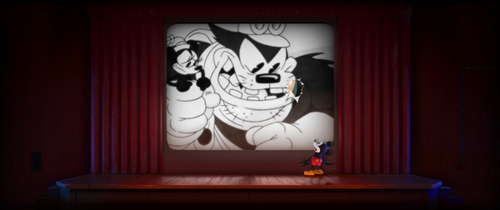
GET A HORSE!
Directed by Lauren MacMullan
Disney's Get a Horse! is one of the two shorts in this year's program that most of the country will have seen already, having played in front of the studio's smash hit Frozen.
The film's selling point - aside from being the first time Mickey Mouse himself has been prominently featured on screen in about two decades - is the way it attempts to reconcile Disney's hand-drawn, black-and-white past with its full-color, computer-animated present. It embeds that idea into the narrative itself, as it begins with a very familiar conflict between Mickey, Minnie and Peg-Leg Pete before leaping into meta territory when Mickey is vaulted through the screen itself, emerging on the other side as a full-color CGI version of himself.
What proceeds is an ongoing slapstick interplay between the two worlds, with director Lauren MacMullan inventively exploiting the various artifices of animated filmmaking (or filmmaking in general, for that matter), and craftily commenting on the varying rules that govern these two distinct eras of animation.
While a few of my colleagues have criticized the film for supposedly disrespecting the 1920s-style animation, I found it to rather be along the lines of The Artist - a film that acknowledged the necessary traction of cinematic technological progress while still celebrating the lineage of the art form.
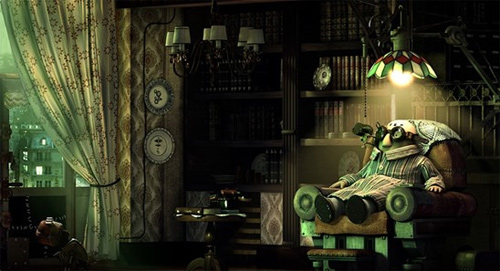
MR. HUBLOT
Directed by Laurent Witz
While seated for the shorts program, I did not expect to be reminded of Ray Kurzweil's The Age of Spiritual Machines, but alas, that's one of the first things that popped in my head when the title character in Mr. Hublot appeared on screen - not because he reflected Kurzweil's theories as a whole, but one such idea specifically, that of the merging of humanity and technology.
OK, this is a more industrial, less A.I.-centric version of that idea, but just go with me. In the world of this film (one of my two favorites from this year), seemingly everything is made up of mixed-and-matched mechanical parts, including people like the obsessive-compulsive and agoraphobic Hublot (wordless, like Jacques Tati's M. Hulot) and his mechanical pet dog. The absurdist development of that relationship - between man-machine and dog-machine - is hilarious and somewhat touching. The film's animation - while stylistically probably the most familiar to modern audiences among the five nominees - is buoyed by its ornate and idiosyncratic design details (I'd love to go over this one frame by frame to catch all the details I missed).
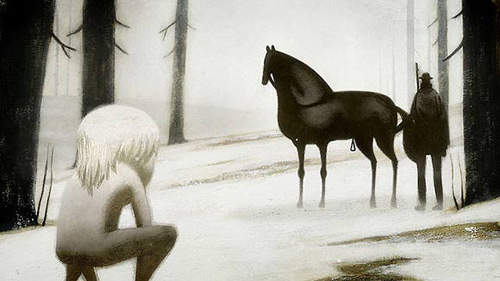
FERAL
Directed by Daniel Sousa
Daniel Sousa's Feral fills the Academy's quota for including one abstract and beautiful film each year that has no chance of actually winning the Oscar. And as it so happens, those often tend to be my favorite. This one seems more in line with 2012's great nominee, Wild Life. Although this one is narratively more along the lines of Truffaut's The Wild Child.
Feral centers around a young boy raised in the wild by wolves, and his struggle to assimilate into human culture after a hunter discovers him and takes him in. What sets this film apart is the painterly expressionism of Sousa's hand-drawn visuals, which reduces its color scheme primarily to blacks, whites and greys and limits the characters' physical details to the bare essentials. The stylistic choices are a great way to express the boy's vague and fluid emotional and intellectual experience in what is probably the most sophisticated and unique of this year's nominees.
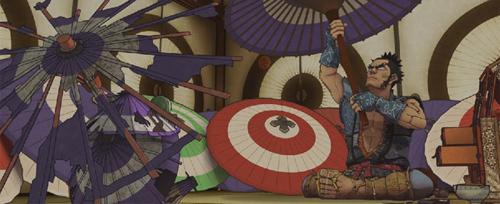
POSSESSIONS
Directed by Shohei Morita
Once again, a hunter plays a central role, this time in Shohei Morita's Possessions. This time, the hunter (and apparent handyman) gets lost in the woods and stumbles upon a hut filled with old broken and discarded items.
A title card at the beginning of the film has already warned us of an old fable about tools and instruments attacking their inventors after 100 years. I'm not exactly sure how well the ensuing story follows through on that idea, but it makes for an entertaining and playful bit of surrealism nonetheless.
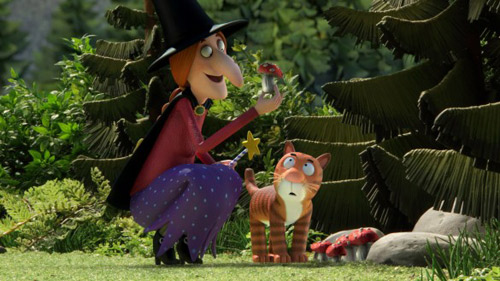
ROOM ON THE BROOM
Directed by Jan Lachauer and Max Lang
This is starting to become a problem. To the extent that I think the Academy - and whomever puts together the full animated shorts program - is playing an extended prank on me. Or on all of us. That's right, Academy - we're onto you. At this point you're just trolling.
What I'm referring to is movies like Room on the Broom, yet another short from director Max Lang (and Jon Lachauer) and adapted from a Julia Richardson story. This was the same pairing responsible for 2009's awful nominee The Gruffalo, a painfully redundant and simplistic fable that snagged A-list voice talent for what amounted to a bad nursery rhyme. It got even worse a couple of years later, when a sequel, The Gruffalo's Child - which I originally mistook for the same short I'd already seen - went un-nominated but still managed to find its way into the shorts program, much to the audience's chagrin.
And now this.
Within the first minute of Room on the Broom, I was certain that these were the same filmmakers. And not surprisingly, this one is the exact same type of thing - we see the same scene over and over, and it plods along at a leisurely pace, tipping in at 26 minutes. And aside from a few nice touches, this is, once again, crap. Admittedly, the audience I was with seemed to disagree, laughing and clapping their way through it. But I've seen so much great animation over the years - shorts and features - and this is the exact opposite of all of that. It's bad poetry, bad animation and bad storytelling. These filmmakers must be stopped.
À LA FRANÇAISE
Directed by Morrigane Boyer, Julien Hazebroucq, Ren-Hsien Hsu, Emmanuelle Leleu and William Lorton
One thing I certainly did not expect to see in an animated shorts program was an oral-sex sight gag involving chickens. But that's exactly what I got with À la Française, a bawdy satire of the French aristocracy, set at Versailles in the 18th Century. It's not my favorite piece of pure animation in the bunch, but a few individual bits of comedy alone are more than worth it.
THE MISSING SCARF
Directed by Eoin Duffy
On one hand, The Missing Scarf feels like it was animated over one long afternoon on a MacBook. On the other hand, it's still pretty funny (largely on the strength of George Takei's terrific narration), especially when it takes one completely absurd turn, and then doubles-down with something even more twisted.
THE BLUE UMBRELLA
Directed by Saschka Unseld
And finally we come to the other short that most of us will have already seen, Pixar's The Blue Umbrella, which ran in front of last summer's Monsters University. And like its corresponding feature-length film, this one does not represent the best of Pixar.
The key problem is that its central storyline defeats (or at least undermines) the entire stylistic idea. The conceit is built on the anthropomorphism of various inanimate objects on a rainy night in the city. But the way the animators do this is they use the actual shape and design of everything in this city - the mailbox, the store window, the rain gutter - and exploit the face-like qualities of those objects to bring them to life.
But then there's the story, which centers on two umbrellas - one blue, one red - and the filmmakers abandon any sense of stylistic consistency. The umbrellas don't lend themselves to the same kind of design. So what does the movie do? It paints two dotted eyes and a mouth on the front of both umbrellas. And that's it. Unlike literally every single other anthropomorphized item in the film, the umbrellas don't have any natural facial design features at all - they just have a face drawn on them.
The Blue Umbrella is, of course, made with grace and charm, but it comes across as both narratively and stylistically lazy.
Read more by Chris Bellamy